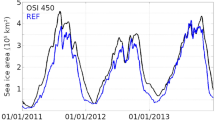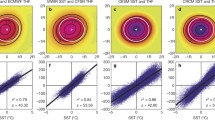Abstract
The Oregon State University coupled upper ocean-atmosphere GCM is evaluated in terms of the simulated winds, ocean currents and thermocline depth variations. Although the zonal wind velocities in the model are underestimated by a factor of about three and the zonal current velocities are underestimated by a factor of about five, the model is seen to qualitatively simulate the major features of the gyral scale currents, and the phases of the seasonal variation of the principal equatorial currents are in reasonable agreement with observations. The simulated tropical currents are dominated by Ekman transport and the eastern boundary currents do not penetrate far enough equatorward, while the western boundary currents do not penetrate far enough poleward. The subtropical trade wind belt and the mid-latitude westerlies are displaced equatorward of observations; hence, the mid-latitude eastward currents, principally the Kuroshio-North Pacific Drift and the Gulf Stream-North Atlantic Current are displaced equatorward. In spite of these shortcomings the surface current simulation of this two-layer upper ocean model is comparable with that of other ocean GCMs of coarse resolution. The coupled model successfully simulates the deepening of the thermocline westward across Pacific as a consequence of the prevailing Walker circulation. The region of most intense simulated surface forcing is located in the western Pacific due to a southwestward displacement of the northeast trade winds relative to observations; hence the equatorial Pacific is dominated by eastward propagation of thermocline depth variations. The excessively strong Ekman divergence and upwelling in the western Pacific cools the local warm pool, while incorrectly simulated westerlies in the eastern Pacific suppress upwelling and inhibit cooling from below. These features reduce the simulated trans-Pacific sea-surface temperature gradient, weakening the Walker circulation and the anomalies associated with the simulated Southern Oscillation.
Similar content being viewed by others
References
Alexander RC, Mobley RL (1976) Monthly averaged sea surface temperatures and ice-pack limits on a 1° global grid. Mon Wea Rev 104:143–148
Bryan K, Manabe S, Pacanowski RC (1975) A global ocean-atmosphere climate model: Part II The oceanic circulation. J Phys Oceanogr 5:30–46
Cane MA, Zebiak SE (1985) A theory for El Nino and the Southern Oscillation. Science 228:1085–1087
Currie RG, Hameed S (1988) Evidence of quasi-biennial oscillations in a general circulation model. Geophys Res Lett 15:649–652
Currie RG, Hameed S (1990) Atmospheric signals at high latitudes in a coupled ocean-atmosphere general circulation model. Geophys Res Lett 17:945–948
Ghan SJ, Lingaas JW, Schlesinger ME, Mobley RL, Gates WL (1982) A documentation of the OSU two-level atmospheric model. Report 35: Climatic Research Institute, Oregon State University, Corvallis, OR, USA
Gill AE (1975) Models of equatorial currents. Proc. Syrup. Numerical Models of Ocean Currents, Durham, NH, USA. Nat Acad Sci 181–203
Gill AE (1982) Changes in the thermal structure of the equatorial Pacific during the 1972 El Nino as revealed by bathythermograph observations. J Phys Oceanog 12:1373–1387
Hameed S, Pittalwala I (1991) The North Pacific Oscillation: observations compared with simulation in a general circulation model. Clim Dyn 6:113–122
Hameed S, Sperber KR, Cess RD (1989) Genesis of the Southern Oscillation within the atmosphere: illustration with global general circulation models. Geophys Res Lett 16:691–694
Han Y-J (1984a) A numerical world ocean general circulation model, part I. Basic design and barotropic experiment. Dyn Atmos Oceans 8:107–140
Han Y-J (1984b) A numerical world ocean general circulation model, part II. A baroclinic experiment. Dyn Atmos Oceans 8:141–172
Han Y-J, Gates WL, Schlesinger ME (1985) An analysis of the air-sea-ice interaction simulated by the' OSU-coupled atmosphere-ocean general circulation model. In: Nihoul JCJ (ed) Coupled ocean-atmosphere models. Elsevier Oceanography Series, New York, pp 167–182
Harrison DE, Giese BS, Sarachik ES (1990) Mechanisms of SST change in the equatorial waveguide during the 1983–83 ENSO. J Clim 3:173–188
Knauss JA (1963) Equatorial current systems. In: Hill MN (ed) The Sea, Vol. 2. Interscience Publishers, New York, pp 235–251
Lamb HH (1972) Climate present, past, and future, Vol. 1 Fundamentals and climate now. Methuen, London. 613 pp
Lemasson L, Piton B (1968) Anomalie dynamique de la surface de la mer le long de l'equateur dans l'Ocean Pacifique. Cah ORSTROM, Ser Oceanog 6:39–46
Manabe S, Stouffer RJ (1988) Two stable equilibria of a coupled ocean-atmosphere model. J Clim 1:841–866
Manabe S, Bryan K, Spelman MJ (1979) A global ocean-atmosphere climate model with seasonal variation for future studies of climate sensitivity. Dyn Atmos Oceans 3:393–426
Meehl GA (1982) Characteristics of surface current flow inferred from a global ocean current data set. J Phys Oceanogr 12:538–555
Meehl GA (1989) The coupled ocean-atmosphere modeling problem in the tropical Pacific and Asian monsoon regions. J Clim 2:1146–1163
Meehl GA (1990) Seasonal cycle forcing of El Niño-Southern Oscillation in a global, coupled ocean-atmosphere GCM. J Clim 3:72–98
Meehl GA, Washington WM, Semtner Jr AJ (1982) Experiments with a global ocean model driven by observed atmospheric forcing. J Phys Oceanogr 12:301–312
Meyers G (1979) Annual variation in the slope of the 14°C isotherm along the equator in the Pacific Ocean. J Phys Oceanog 9:885–891
Neelin JD, Latif M, Allaart MAF, Cane MA, Cubasch U, Gates WL, Gent PR, Ghil M, Gordon C, Lau NC, Mechoso CR, Meehl GA, Oberhuber JM, Philander SGH, Schopf PS, Sperber KR, Sterl A, Tokioka T, Tribbia J, Zebiak SE (1992) Tropical air-sea interaction in general circulation models. Clim Dyn 7:73–104
Niiler PP, Kraus EB (1977) One-dimensional models of the upper ocean. In: Kraus EB (ed) Modelling and prediction of the upper layers of the ocean. Pergamon Press, New York, pp 143–172
Philander SGH, Lau NC, Pacanowski RC, Nath MJ (1989) Two different simulations of the Southern Oscillation and El Niño with coupled ocean-atmosphere general circulation models. Phil Trans R Soc Lond A 329:167–178
Pittalwala I, Hameed S (1991) Simulation of the North Atlantic Oscillation in a general circulation model. Geophys Res Lett 18:841–844
Pollard D (1982) The performance of an upper-ocean model coupled to an atmospheric GCM: Preliminary results. Climatic Research Institute, Report No. 31, Oregon State University, Corvallis, Oregon, USA
Sausen R, Barthel K, Hasselman K (1988) Coupled ocean-atmosphere models with flux correction. Clim Dyn 2:145–164
Schlesinger ME, Gates WL (1980) The January and July performance of the OSU two-level atmospheric general circulation model. J Atmos Sci 37:1914–1943
Schlesinger ME, Gates WL (1981) Preliminary analysis of the mean annual cycle and interannual variability simulated by the OSU two-level atmospheric general circulation model. Report No. 23, Climatic Research Institute, Oregon State University, Corvallis, OR, USA
Semtner AJ (1974) An oceanic general circulation model with bottom topography. Numerical simulation of weather and climate Tech. Report 9, Department of Meteorology, University of California, Los Angeles, USA
Semtner AJ Jr, Chervin RM (1988) A simulation of the global ocean circulation with resolved eddies. J Geophys Res 93:15 502–15 222
Sperber KR (1989) Southern Oscillation simulation in coupled ocean/atmosphere global climate models. Ph D Dissertation, State University of New York at Stony Brook, Stony Brook, NY, USA
Sperber KR, Hameed S (1991) Southern Oscillation simulation in the OSU coupled upper ocean-atmosphere GCM. Clim Dyn 6:83–97
Sperber KR, Hameed S, Gates WL, Potter GL (1987) Southern Oscillation simulated in a global climate model. Nature 329:140–142
Washington WM, Meehl GA (1989) Climate sensitivity due to increased CO2: experiments with a coupled atmosphere and ocean general circulation model. Clim Dyn 4:1–38
Washington WM, Semtner AJ Jr Meehl GA, Knight DJ, Mayer TA (1980) A general circulation experiment with a coupled atmosphere, ocean, and sea ice model. J Phys Oceanogr 10:1887–1908
Wyrtki K, Kilonsky B (1984) Mean water and current structure during the Hawaii-to-Tahiti shuttle experiment. J Phys Oceanogr 14:242–254
Yuen CW, Cherniawsky JY, Lin CA, Mysak LA (1992) An upper ocean general circulation model for climate studies: global simulation with seasonal cycle. Clim Dyn (in press)
Author information
Authors and Affiliations
Additional information
Offprint requests to: KR Sperber
Rights and permissions
About this article
Cite this article
Sperber, K.R., Hameed, S. & Lawrence, W.G. Surface currents and equatorial thermocline in a coupled upper ocean-atmosphere GCM. Climate Dynamics 7, 121–131 (1992). https://doi.org/10.1007/BF00211154
Received:
Accepted:
Issue Date:
DOI: https://doi.org/10.1007/BF00211154




